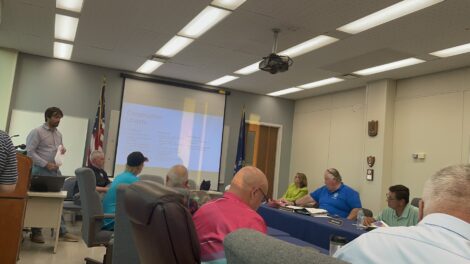Amended Housing Project Receives Planning Commission Approval
The Blooming Gardens project, a collaboration between Southern Tier Environments for Living and CODE Inc., is a step closer to reality after receiving approval from the city Planning Commission.
Matt Long with Long Architects presented the proposal to the commission during their most recent meeting, beginning by acknowledging that this project has been presented twice before, and that they have taken previous comments from the commission and the zoning board during the last presentation into account.
“This is part of now a 44 unit, multi-site development, with application going into New York State Homes and Community Renewal,” Long said. “Chris Jock, CEO of CODE Inc, and Tom Whitney, CEO of STEL, those are the two nonprofit agencies that are partnering to make this happen.”
Long said the land they are putting the project on was identified by the Chautauqua County Land Bank as being prime for development such as this, and they were originally approached by them to do some sort of project. He noted that the existing seven parcels are not conforming to the current zoning code as it is written, but that they thought they could fit reasonably sized residences that would fit the neighborhood, so that is what they went with. This original idea was approved by the Planning Commission pending approval from the Zoning Board of Appeals, Chautauqua County Planning Board, and a little bit of work on the stormwater and drainage of the project, which is something that has been included now in the revised proposal. The project had to be reconfigured after it was denied by the Zoning Board of Appeals. Long said they returned now with an amended proposal, though he added he was not able to be in person at the last ZBA meeting so he thought some things maybe did not get fully explained.
Comments from the ZBA included; the project was too far from the zoning requirements for the lot width area, too dense and potentially not the right proportions for the site, drainage concerns and whether or not there was enough parking.
The new amended proposal takes the existing width of the original proposal was between around 48 and 52 feet, and the new proposal looks to get those much closer to what the current zoning code requires — which is a 70 foot lot width for a two-family residence, along with a 10,000 square foot lot for a two-family house. Long said they are making “drastic strides” to get as close as they can to what the zoning calls for, and discussed the planned changes in what he said they felt were smart changes, though he said they are still not fully compliant.
Essentially, he said the project is the same as before with the main difference being how the parcels will lay out. He also addressed how the new plans fixed the drainage issues and concerns that have been talked about previously as well.
The original plan was to take the stormwater from the driveway and put it to the rear of the property, where the storm liters from the roof were going to the street. Now, after talking with Public Works Director Mark Roetzer, Long said in order to be less bothersome to the neighbors they have decided to take everything to the street.
“So really, we’re trying to meet in the middle and have the best compromise we can have here, given what we think makes sense from a density standpoint fitting harmoniously with the neighborhood and also with the reality of being able to build it with the least amount of houses we can build to successfully put forward an application,” Long said.
Other ZBA comments included having more of a greenspace and enough of a yard for residents, and Long addressed that while there is a slope behind the residences, they have also expanded the space behind them for more yard spaces for residents. He also addressed the size of the buildings being within the parameters from the state for one bedroom units and that the houses cannot go much bigger in order to apply to Homes and Community Renewal, which he said came up in another previous comment.
Long talked a bit more about the elevation and parking, and it was also addressed that the city’s upcoming planned zoning changes may also help with things like the parking.
The Planning Commission approved the project to move forward again. The project will now go before the Zoning Board, even if the city council approves the creation of Pilot Residential Districts at Monday’s voting session, which will allow for infill housing projects in the city, including on Spring Street, and the project will also go before the County Planning Board.



